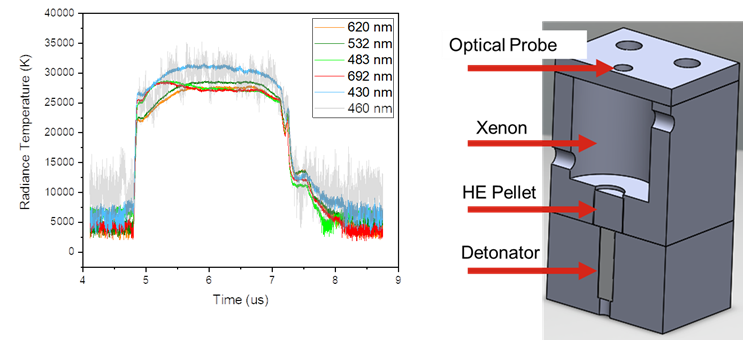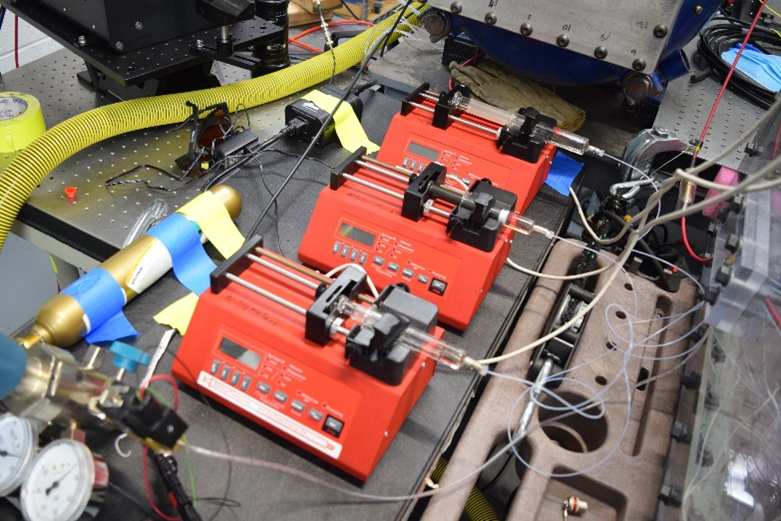
Homogenous Detonation of High Explosive by High Intensity Non-Coherent Radiation

Project #: 22-120 | Year 1 of 2
Thomas Myers, Brandon La Lone, Jason Mance, Gerald D. Stevens, William D. Turley
Special Technologies Laboratory
Executive Summary
This project is developing a technique to generate a homogenous pressure drive for shock physics applications. High intensity incoherent light will be used to simultaneously initiate the entire surface of a sensitive high explosive, generating a uniform pressure profile. If successful, this technique would replace current HE plane-wave lenses, lowering both the complexity and cost of shock-based experiments, as well as allowing access to new more complex shock geometries not currently attainable.
Description
The current technique for generating planar, cylindrical, or spherical shocks utilizes explosive lenses. While this technique generates shock waves that have a uniform arrival time at the desired location, the pressure profiles behind the shock front are not uniform and the symmetry quickly decays. High explosive lenses are also complicated and costly to produce. This project seeks to develop an alternative technique that utilizes incoherent light to uniformly initiate a sensitive high explosive to achieve both simultaneous arrival of shock waves and uniform pressure behind the shock front.
This year the project has successfully developed and characterized a high explosive incoherent light source, and has established the safety basis for performing experiments with the sensitive primary explosives required. Figure 1 shows the light output from the explosively driven Xenon light source as well as the experimental configuration. As the shock wave passes through the Xenon the gas is shock compressed and heated to temperatures between 25,000 and 30,000 K and emits visible and ultraviolet light at power densities above 1 MW/cm2. Due to the difficulty of utilizing light to initiate explosives, it is necessary to use sensitive primary explosives for optical initiation. To achieve this safely, this project developed the safety basis and experimental setup to remotely form primary explosives. Figure 2 shows the remote injection system that allows for the mixing of liquid fuels (i.e., nitromethane, nitrotoluene) with strong liquid oxidants (i.e., concentrated nitric acid). These mixtures are known to be extremely sensitive to external stimuli and should have low optical initiation thresholds.
This work will continue in Fiscal Year (FY) 2023 utilizing a high-power q-switched Nd:YAG laser to determine the optical initiation thresholds of the liquid explosive mixtures. Once established, the laser will be replaced with the high intensity Xenon light source to achieve large area simultaneous initiation. If successful in generating a planar shock wave, the technique will expand to look at cylindrical and spherical shock geometries.


Conclusion
This FY we have demonstrated a high intensity light source and developed the safety basis and experimental setup for safely generating sensitive liquid primary explosives. We have found that explosively shocked xenon gas achieves a temperature of at least 25,0000 K and outputs visible and ultraviolet light at power densities of a least 1 MW/cm2. At this level of light production, it is anticipated that there will be enough optical power to initiate primary explosives. Furthermore, establishing the hardware and procedures required to work with primary explosives is a significant step towards the successful execution of the project goals and represents the first significant work with primary explosives under the MSTS contract. Moving forward we will utilize the new capabilities developed during this FY to achieve the optical initiation of high explosives with incoherent light and characterize the uniformity of the pressure drive created.
Mission Benefit
The development of an improved high explosive drive system will have a significant impact on the design and execution of a wide range of shock physics experiments. Replacing complex explosive lenses with a simpler and higher performing optical initiation system will enable planar and converging shock geometries at laboratory scale. The work done this FY established the components of the technique that will be developed in the coming year. Additionally, the optimization of the xenon light source may have applications where high intensity light sources are needed for back lighting or schlieren imaging.
This work was done by Mission Support and Test Services, LLC, under Contract No. DE-NA0003624 with the U.S. Department of Energy. DOE/NV/03624–1620.
Return to Dynamic Experiment Diagnostics
Go to SDRD Annual Report Index
Return to SDRD Homepage
